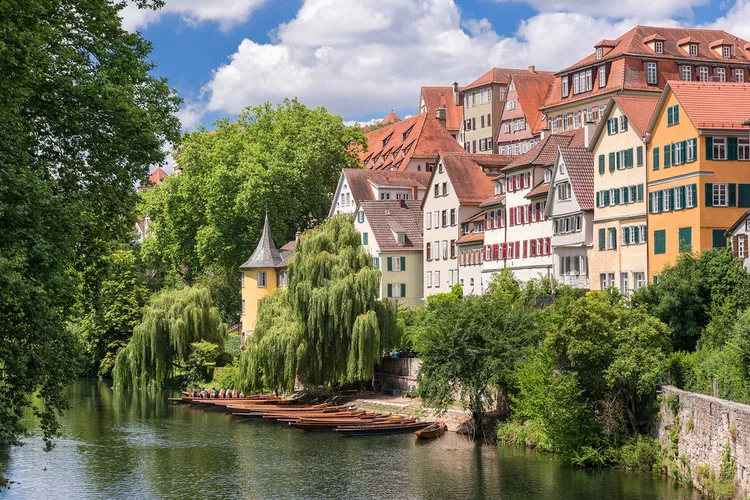Explore Germany’s Hidden Small Town Gems
Come for the beer halls, stay for the beautifully preserved architecture.
Berlin and Munich may be Germany’s most-visited cities, but taking advantage of the country’s excellent rail system (or simply renting a car) and venturing outside the major metropolises is the best way to experience a quieter side of German culture. Enjoy the remarkable landscapes as you make your way through the countryside, then relish a dive into local history and tradition with a visit to any of these 12 small towns in Germany.
Flensburg
:max_bytes(150000):strip_icc():format(webp)/flensburg-SMTOWNGERM0122-dc1fd9188acb4c4e8bbef9d12632eae8.jpg)
Flensburg sits just four miles from the Danish border, and the Scandinavian influence is palpable in both culture and design. Spend an afternoon sailing on the Flensburg Fjord, or admire the city’s historic harbor — an essential element of this trading port — on foot. In either case, a stroll through the well-preserved old town while learning about Flensburg’s rum-soaked history is a must.
Stralsund
:max_bytes(150000):strip_icc():format(webp)/stralsund-SMTOWNGERM0122-d82a6cd7680c4384b6bc5c33fead79d7.jpg)
Formally recognized as the Hanseatic City of Stralsund, this small northern city is a UNESCO World Heritage Site thanks to its fine examples of Brick Gothic architecture. Visit the 13th-century city hall, admire the colorful gabled townhouses of medieval merchants, and have a drink in the cozy 16th-century cellar at Restaurant Hansekeller.
Görlitz
:max_bytes(150000):strip_icc():format(webp)/gorlitz-SMTOWNGERM0122-038d05a32fef4607a176dd3018bdf9de.jpg)
Germany’s easternmost town quite literally straddles the Germany-Poland border — just cross the Neisse River by footbridge from Görlitz, and you’ll find yourself in the Polish city of Zgorzelec. Filled with architectural examples throughout the epochs of its 950-year history, Görlitz is so remarkably scenic that more than 100 films have been produced here in “Görliwood.”
Heppenheim
:max_bytes(150000):strip_icc():format(webp)/heppenheim-SMTOWNGERM0122-4ae8fe9c1cad4abe91895dcc7ed94cf4.jpg)
Heppenheim is one of those little German towns that elicits the use of tired descriptors like “charming,” “picturesque,” and “like a fairy tale” because despite the cliché, it is all of those things. If you’re into half-timbered houses and history dating back to 755, you’ll love this cheerful city. Don’t miss the views from Starkenburg Castle, which overlooks the Rhine Valley in all of its vineyard-laden glory.
Gößweinstein
:max_bytes(150000):strip_icc():format(webp)/goessweinstein-SMTOWNGERM0122-e8110d2ba80249cbad2ce2a38daea518.jpg)
Located in a region known as Franconian Switzerland, Gößweinstein (with a population of 4,084) is surrounded by rolling green hills and forested hiking trails. You’ll find the best views from the town’s castle, which was allegedly built more than 1,000 years ago. Fun fact: Franconian Switzerland has the highest density of breweries in Europe, so come thirsty!
Kelheim
:max_bytes(150000):strip_icc():format(webp)/kelheim-SMTOWNGERM0122-d11cd27cf25345f4b738964a34fb5787.jpg)
Kelheim has many endearing qualities — including a hillside-perched neoclassical monument and a vibrant city center — but it’s the journey by ferry along the Danube Gorge to Kloster Weltenburg that is perhaps the biggest draw. A 40-minute cruise through scenic river landscapes deposits you at the world’s oldest monastery brewery where the beer is cold, the food is excellent, and the views are spectacular.
The Best Small Towns in Europe
Passau
:max_bytes(150000):strip_icc():format(webp)/passau-SMTOWNGERM0122-ee4ba148b1cb4ab0af97cec9a89bb564.jpg)
Known as the “city of three rivers,” Passau sits near the Austrian border at the confluence of the Inn, Ilz, and Danube rivers. Baroque architecture is as much a visual highlight of this small city as is its geographic setting, so enjoy a riverfront room at Hotel Residenz to enjoy classic Bavarian ambiance within walking distance to the majestic St. Stephen’s Cathedral.
Bad Reichenhall
:max_bytes(150000):strip_icc():format(webp)/bad-reichenhall-SMTOWNGERM0122-5706c239cbcf4daca7540935aaea60b0.jpg)
Bad Reichenhall is a true alpine gem and arguably the most beautiful small town on this list. The flanking mountains suggest a winter sports haven, but the excellent hiking, rich cultural scene, and the restorative waters of Bad Reichenhall’s own AlpenSole brine — a salty relic of the primeval sea — ensure that this is very much a year-round destination.
Tübingen
:max_bytes(150000):strip_icc():format(webp)/tublingen-SMTOWNGERM0122-b2edb67f0b7f4c56827f0f12a0e2f7e3.jpg)
There’s a studious, creative energy to this medieval university town, which dates back to 1078. A wonderland for lovers of literature, Tübingen hosts an annual book festival and boasts Germany’s highest number of bookstores per capita. If books aren’t your thing, you can check out Hohentübingen Castle, walk along the Neckar River, and enjoy a plate of local fare — Maultaschen, a.k.a. filled dumplings, are a specialty of the region — at Mauganeschtle.
Lingen
:max_bytes(150000):strip_icc():format(webp)/lingen-SMTOWNGERM0122-e2621767e5f1429990f41186ac5f9a58.jpg)
If rivers seem like a common theme among German cities, you won’t be surprised to learn that Lingen overlooks the Ems River. This little town’s long history (dating back to 975) is reflected in its collection of historic buildings, twice-weekly farmer’s markets, and lingering traditions. For a unique experience, time your visit to Lingen during the triennially hosted Kivelingsfest — a celebration of medieval crafts and culture.
Lüneburg
:max_bytes(150000):strip_icc():format(webp)/luneburg-SMTOWNGERM0122-4fcab9d81f684d708de9c4018a2682c5.jpg)
Lüneburg flourished for centuries thanks to the salt trade, and the city remains especially lovely today since it was spared from World War II damage. Beyond the colorful and intact medieval city center, there are thermal baths, lush gardens, and attractions like the German Salt Museum and the Lüneburg Brewery Museum begging to be explored.
Wolfenbüttel
:max_bytes(150000):strip_icc():format(webp)/wolfenbuttel-SMTOWNGERM0122-6346b90e1e2246faa682ebc848f85f36.jpg)
Anyone up for a shot of Jägermeister? The popular herbal liqueur is one of Wolfenbüttel’s claims to fame — along with its collection of more than 600 half-timbered buildings, a magnificent Baroque palace, and the Herzog August Library. Come to Wolfenbüttel for the atmospheric city center (and, sure, the 56-herb booze), stay for the thriving culinary and cultural scenes.




